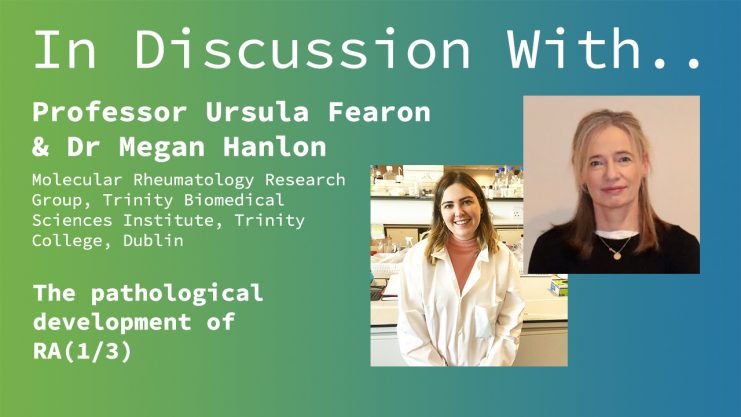Advertisment
The pathological development of rheumatoid arthritis

Interview and article by Christine Clark.
Recent research into the molecular basis for rheumatoid arthritis may be pointing the way to targeted therapy to prevent inflammation and joint damage. IMI interviewed Professor Ursula Fearon and Dr Megan Hanlon from the molecular rheumatology research group at Trinity College, Dublin to find out more.
The molecular rheumatology research group is strongly focused on translational research – the bench to bedside approach – with an emphasis on patient involvement and engagement. “There are three partners in our research – the clinical team, the scientific team but, most importantly, the patient – because without the patient we couldn’t do this type of research”, says Professor Fearon
Study background
About 20 years ago treatment of rheumatoid arthritis started when patients already had established disease and functional disability resulting from joint destruction. A new era of drug development enabled treatment to start at the clinical onset stage. Now, researchers are starting to look at individuals at the pre-disease stage and trying to predict whether they will develop rheumatoid arthritis. The study in question looked at two cohorts of patients, one with established rheumatoid arthritis and a second cohort of patients comprising ‘individuals at risk’ of developing rheumatoid arthritis.
Rheumatoid arthritis is a chronic, autoimmune disease characterised by systemic inflammation. At the same time new blood vessels are formed in the synovium and these allow immune cells to migrate into joints where they activate inflammation causing cartilage and bone destruction and functional disability. “We don’t know what the trigger for rheumatoid arthritis is but we know that it is a combination of genetic and environmental factors and it is this combination that causes a change in the proteins on our own cells …… and that causes our immune system to mistakenly attack our cells”, explains Professor Fearon. Normally, our immune system attacks foreign pathogens such as viruses and bacteria whereas in autoimmune diseases the immune system attacks our own tissues. Activation of the immune system in this way involves immune cells in the circulation including monocytes, T cells and B cells. In this situation, B cells produce autoantibodies such as ACPA (anti-citrullinated protein antibodies) which is present in about 70% of patients with rheumatoid arthritis. This is helpful in distinguishing rheumatoid arthritis from other forms of inflammatory arthritis.
Professor Fearon explains: “So, once these cells in our circulation are activated they get a second signal that instructs them to migrate to the joint where they basically ‘set up shop’ in the synovial membrane, they produce potent inflammatory mediators that cause the inflammation.” Turning to the second cohort – the patients that do not have rheumatoid arthritis – she says, “Basically these are individuals that present to their GP [with] aches and pains. They don’t have any clinical manifestations of rheumatoid arthritis but what they do have is these autoantibodies in their blood so we reckon that these individuals have the genetic background. They’ve had some environmental insult – like they might smoke or they might have had some pathogens that caused the insult – but they didn’t get that second signal to cause those cells to migrate to the joints to develop rheumatoid arthritis.”
The purpose of the study was “to figure out how we find a signature in the patients with rheumatoid arthritis that possibly is also present in these individuals pre-disease and how we predict when they might develop rheumatoid arthritis”, says Professor Fearon.
Monocytes
Monocytes are very important because they are crucial innate effector cells central to driving rheumatoid arthritis. Three main actions are important in this situation. First, monocytes phagocytose antigens and rid the body of invading pathogens, second, they produce abundant pro-inflammatory mediators and, third, when they receive the ‘second signal’ they migrate to the joints and become involved in the inflammatory process. Once in the joints “they can actually change into three different cell types – dendritic cells, macrophages or osteoclasts and those three cell types are really important in further driving the inflammation in the joint. The dendritic cell and the macrophage cause the synovial inflammation to invade the cartilage but the third cell, the osteoclasts, cause holes to be eaten in the bone and this causes the [joint] dysfunction”, says Professor Fearon.
In summary, monocytes are central both to the systemic inflammation and the joint inflammation in driving this disease.
Read and watch the full series on our website or on YouTube.
Professor Ursula Fearon is Head of Molecular Rheumatology in the Trinity Biosciences Institute in Trinity College Dublin. This research group is focused on investigating the pathogenic mechanisms involved in driving autoimmune diseases, specifically rheumatoid arthritis and psoriatic arthritis.
Dr Megan Hanlon is a post-doctoral research fellow in Professor Fearon’s molecular rheumatology research group. Her PhD and post-doctoral research is focused on the myeloid compartment of the synovial joints, specifically monocytes and macrophages.





